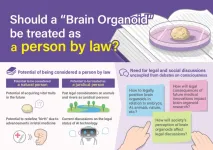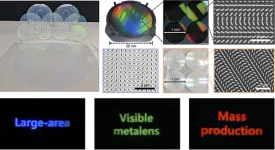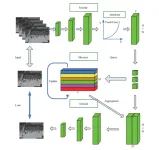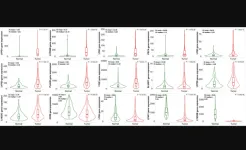(Press-News.org) Grown in labs, human brain organoids are cultivated from stem cells, feed on nutrient broth and serve as a model of human brain development in miniature. Their growth and structure mimic portions of real brains, allowing scientists to better investigate the origins and potential treatments of neural diseases. How similar are they to actual human brains, though? Are they close enough to be considered people in their own right?
The question is complicated in myriad ethical and moral ways, but researchers based in Japan and Taiwan propose that the legal lens may prove critical when understanding the potential personhood of human brain organoids.
They published their argument for a legal framework to guide the conversation on April 3 in the Journal of Law and Biosciences.
“The moral status of human brain organoids has often been discussed, but their legal status has rarely been discussed,” said corresponding author Tsutomu Sawai, associate professor in the Graduate School of Humanities and Social Sciences at Hiroshima University. “To clarify the legal status of human brain organoids will illuminate issues such as what information should be informed to the cell donor, to what extent the donor’s consent justifies the research, and what uses are acceptable.”
Legal person refers to any entity that holds legal rights and obligations — it can be human or not, according to Sawai. Human legal persons are called natural persons, and they are defined by being born of a womb and whether they can be considered legal dead once their heart or brain stops working. Nonhuman legal persons are called juridical persons and can include corporations and governmental agencies.
In their paper, Sawai and his team explore how the legal definition of what it means to be a natural or a juridical person applies to human brain organoids. Currently, the organoids do not fulfill basic requirements of what it means to be a natural person, Sawai said, but research may bridge the existing gaps.
“Although human brain organoids do not constitute natural persons at present, the likelihood of their potential to become natural persons in the near future requires more thorough consideration in advance of that reality occurring,” said first author Masanori Kataoka, researcher in Hiroshima University’s Graduate School of Humanities and Social Sciences. “Research on linking human brain organoids with bodies is expected to advance rapidly in the coming years, whereas the conditions of natural personhood, especially viability and birth are becoming increasingly flexible and contentious.”
The researchers noted that previous discussions on this topic have focused almost exclusively on natural personhood, overshadowing questions about the potential juridical personhood of human brain organoids. Corporations, for example, are considered juridical persons so that they can participate in legal matters, such as entering contracts. According to Kataoka, whether this applies to human brain organoids would depend on what legal purposes such consideration may have, and the matter should be considered separately from whether they are natural persons.
“Current brain organoid technology is in many ways quite limited, and it has not yet reached a stage where human brain organoids could become natural or juridical persons,” Sawai said. “However, as we have emphasized, this issue will soon become urgent once brain organoid technology has been further developed. In preparation for that time, it is essential to examine the accompanying questions thoroughly and in advance; we have taken the first step in that direction.”
##
Sawai is also affiliated with Kyoto University’s Institute for the Advanced Study of Human Biology. Tsung-Ling Lee with Taipei Medical University’s Graduate Institute of Health and Biotechnology Law also co-authored this paper.
The Japan Agency for Medical Research and Development, the Japan Society for the Promotion of Science, the Uehiro Foundation, the Mitsubishi Foundation, the Japan Science and Technology’s Research Institute of Science and Technology for Society funded this work.
About Hiroshima University
Since its foundation in 1949, Hiroshima University has striven to become one of the most prominent and comprehensive universities in Japan for the promotion and development of scholarship and education. Consisting of 12 schools for undergraduate level and 5 graduate schools, ranging from natural sciences to humanities and social sciences, the university has grown into one of the most distinguished comprehensive research universities in Japan. English website: https://www.hiroshima-u.ac.jp/en
END
Can tiny brain tissues legally be a person? Researchers say not yet
2023-05-09
ELSE PRESS RELEASES FROM THIS DATE:
Study finds some MND and dementia patients share genetic defects
2023-05-09
New research has discovered that some patients with motor neuron disease (MND) and frontotemporal dementia (FTD) carry the same rare genetic defects that cause other neurodegenerative diseases.
Researchers from the Macquarie University MND Research Centre and The Walter and Eliza Hall Institute of Medical Research have identified the defects in the genomes of some people with non-inherited, or sporadic, MND and FTD.
MND results in the death of the neurons, or motor nerves, connecting the brain and spinal cord to the muscles. These are the cells that control our ability to move, breathe and swallow. The disease ...
Researchers develop interfacial charge modification strategy to enhance photocatalytic water oxidation
2023-05-09
Water oxidation reaction involves a four-electron and four-proton transfer process, which requires an uphill energy transformation and limits the efficiency of the overall photocatalytic water splitting reaction.
Although loading appropriate water oxidation cocatalysts can enhance the performance of water oxidation reactions, the interfacial barrier between the semiconductor and the water oxidation cocatalyst can impede the transfer and utilization of photogenerated charges.
Recently, a research team led by Profs. LI Can and LI Rengui from the Dalian Institute of Chemical Physics (DICP) ...
Southwest Rural Health Research Center identifies key health challenges of rural America
2023-05-09
The Southwest Rural Health Research Center at the Texas A&M University School of Public Health has published a peer-reviewed paper detailing Healthy People 2030 priorities that will be most critical for rural America in the upcoming decade. These priorities were identified by rural health stakeholders across the United States. This publication comes ahead of the center’s release of Rural Healthy People 2030 — a continuation of a long-standing tradition of the Southwest Rural Health Research Center in which multidisciplinary authors ...
World's first mass production of metalenses for visible wavelengths
2023-05-09
Do you hate the camera bumps on the back of your smartphone? A new optical component called metalens – which was named one of the top 10 future technologies by the World Economic Forum in 2019 – may be the answer. Composed of a nanostructured array, this incredibly thin and lightweight optical device is currently the focus of much attention in the scientific community, even featured in a special issue of Nature Photonics. However, the production of metalenses requires highly precise techniques and can be expensive, posing a challenge for their scalable manufacturing.
In ...
COVAD: Content-oriented video anomaly detection using a self attention-based deep learning model
2023-05-09
Video anomaly detection is a research hotspot in the field of computer vision, attracting many researchers.Video anomaly detection differs from traditional video analysis. Usually, abnormal events occur only in a small percentage of the video pixels and therefore, it is unnecessary to focus on all the video pixels as most of
them are harmless—called “the background”. Therefore, in the video feature extraction process, attention should be focused on a few detectable partial objects. Object detection is very complicated and consumes a significant amount of time during video processing. Therefore, ...
New technique enables in-vivo analysis of protein complexes
2023-05-09
As the executor of life activities, proteins exert their specific biological functions through interactions such as forming protein complexes. The localization effects, crowding effects, and organelle microenvironments within cells are crucial for maintaining the structure and function of protein complexes.
Recently, a research team led by Prof. ZHANG Lihua from the Dalian Institute of Chemical Physics (DICP) of the Chinese Academy of Sciences (CAS) has developed a glycosidic-bond-based mass-spectrometry-cleavable cross-linker, which improves the data ...
Scientists raise concerns about popular COVID disinfectants
2023-05-09
The COVID-19 pandemic has boosted the unnecessary use of antimicrobial chemicals linked to health problems, antimicrobial resistance, and environmental harm, warn more than two dozen scientists in the peer-reviewed journal Environmental Science & Technology. Their critical review details how quaternary ammonium compounds (QACs) are increasingly marketed and used in home, healthcare, education, and workplace settings despite the availability of safer alternatives and in some cases limited evidence of reduced disease transmission.
“Disinfectant wipes containing ...
Virginia Tech, George Mason University partner to develop networking infrastructure for satellite constellations
2023-05-09
The race is on to provide high speed satellite internet to the Earth’s most remote areas. New tech companies such as Starlink, One Web, and Amazon’s Kuiper are competing with traditional, established “satcomm” companies such as Thuraya and Inmarsat to provide global high speed, low latency satellite internet across the globe. These new mega-constellations rely on tens of thousands of small low earth orbit satellites flying at a few hundred miles altitude.
Network interconnectivity is a basic building block for providing the fastest, more reliable coverage to end users. While all these mega-constellations are driven to provide high ...
Lifu Huang receives NSF CAREER award to lay new ground for information extraction without relying on humans
2023-05-08
Considering the millions of research papers and reports from open domains such as biomedicine, agriculture, and manufacturing, it is humanly impossible to keep up with all the findings.
Constantly emerging world events present a similar challenge because they are difficult to track and even harder to analyze without looking into thousands of articles.
To address the problem of relying on human effort in situations such as these, Lifu Huang, an assistant professor in the Department of Computer Science and core faculty at the Sanghani Center for Artificial Intelligence ...
LY6 gene family: potential tumor antigens and prognostic biomarkers in endometrial cancer
2023-05-08
“Importantly, the expression of several LY6 genes is elevated in UCEC [uterine corpus endometrial carcinoma] when compared to the expression in normal uterine tissue.”
BUFFALO, NY- May 8, 2023 – A new research paper was published in Oncotarget's Volume 14 on May 4, 2023, entitled, “Human LY6 gene family: potential tumor-associated antigens and biomarkers of prognosis in uterine corpus endometrial carcinoma.”
The human Lymphocyte antigen-6 (LY6) gene family has recently gained interest for its possible role in tumor progression. In this new study, researchers Luke A. Rathbun, Anthony M. Magliocco ...






